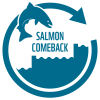CONSERVATION & RESTORATION EFFORTS
Programmes & plans to restore habitats, functionality and biodiversity of the Rhine

In addition to making the structures passable, the Rhine border countries have been working for more than 20 years on the restoration of habitats, dynamics, flood expansion fields, sediment recharge, and the reopening of old branches of the Rhine….
The Rhine 2020 Programme adopted in 2000 by the ICPR will have enabled the restoration of about 140 km2 of alluvial zones and connected more than 150 alluvial streams to the river between 2000 and 2020.
The Rhine 2040 programme, adopted in February by the ICPR 2020, plans to restore 200 km² of alluvial zones and reconnect 100 old branches to the Rhine by 2040.
In concrete terms, with the “Living Rhine” Plan (Dec. 2019-2024) 100 km of river will be restored on the French side to restore the ecological functions of the river, for a more attractive and more resilient territory in the face of climate change..
Focus on the Interreg Rhinaissance project: Renaturation project of the Old Rhine and its alluvial environments in the nature reserve of Taubergießen in Germany and on the island of Rhinau in France (study area of about 19 km²)
Others conservation & restoration efforts, some examples
IN THE SEA
In recent decades several projects have been initiated, with the aim of limiting fishing, e.g.:
- The closure of the professional Norwegian fishery in 1984.
- A substantial fall in the number of fish (predominantly American) taken in Greenland, decreasing from 2200 t to 8t in 2014.
- A substantial fall in the Faroe Islands quota, decreasing from 2200 tonnes to 0, thanks to the voluntary buyback of fishing rights.
- The buyback of fishing rights in the south of England is being discussed.


IN THE DELTA
After 20 years of discussion, some of the gigantic flood control gates at Haringvliet in the Rhine delta of the Netherlands are partial open since november 2018. This measure represents a total investment of €70 million. It opens up the route for the salmon, and may also facilitate the comeback of a viable population of sturgeons (also a migratory fish which disappeared 60 years ago) as well as of oyster banks and supports the development of a sustainable fishery business. more info
This project will allow migration through the Ijsselmeer in the north of the delta where migration dropped in 1932 when the Afshintdijk dam was built.
To facilitate migration, a 4 kilometre artificial river will be built. Together with the tidal influence this will ensure a connection all year long. The investment totals €50 million.
MIDDLE RHINE AND NORTH OF THE UPPER RHINE
Up as far as Iffezheim near to Karlsruhe the Rhine has been freed and the salmon have already taken advantage of this change with populations now found in several tributaries.
Natural spawning now occurs in the Sieg, the Lahn and the lower part of the Ill, in Alsace. In the Mosel, a lot of dams have been removed to allow fish migration and natural recolonization.
Since the installation of fish passes on the French-German hydroelectric power plants in Iffezheim and Gambsheim, salmons can once again take back the Kinzig, a river once teaming with fish.
The Kinzig, situated in Baden-Wurtemberg, was liberated in an exemplary way. The majority of its course with its all-important spawning areas is now again accessible. The presence of a successful salmon farm supports regular recolonization.


SOUTH OF THE UPPER RHINE
Have a look at “fish continuty in the French upper Rhine” page.
UPPER RHINE, BLACK FORREST AND SWITZERLAND
A lot of money has already been invested to enable salmon to reach its reproduction habitats.
In Basel and in the petite Camarque in the Alsace, eggs and juvenile salmon are set released on an annual basis.
The Dreisam and the Elz, the entire Old Rhine, the Wiese, the Swiss Birs and the Aare are all waiting for the arrival of the salmon.
If the salmon reach Basel, the spawning areas in the Upper Rhine and its tributaries would all be available for reproduction, which would mean a doubling of the spawning and juvenile habitats in one go!
